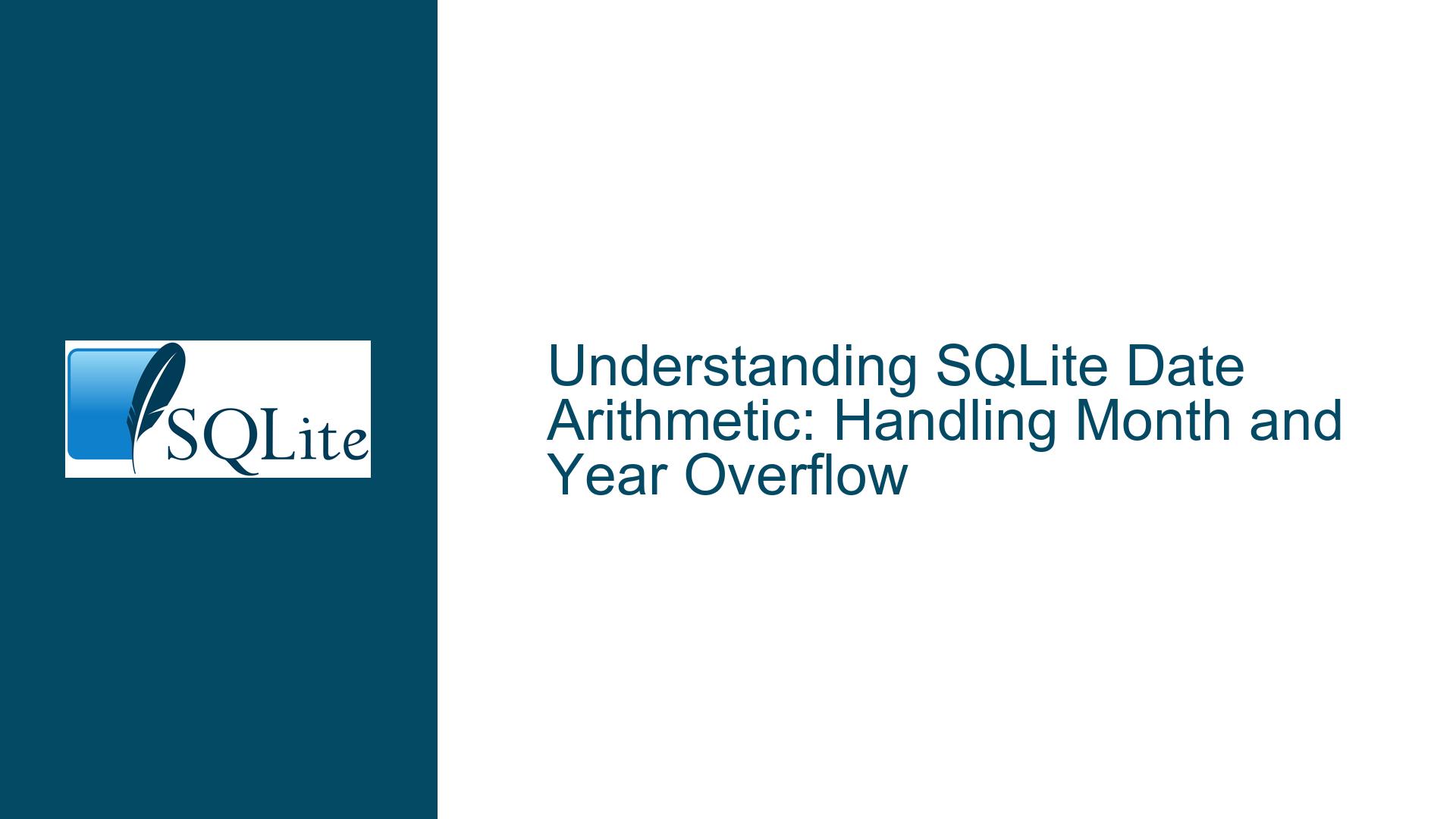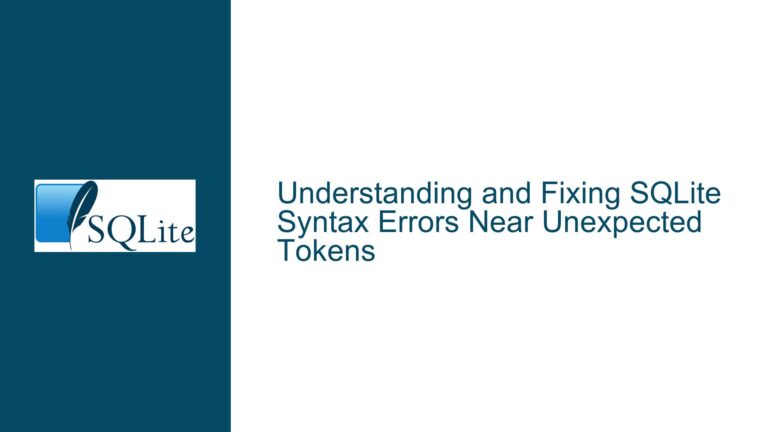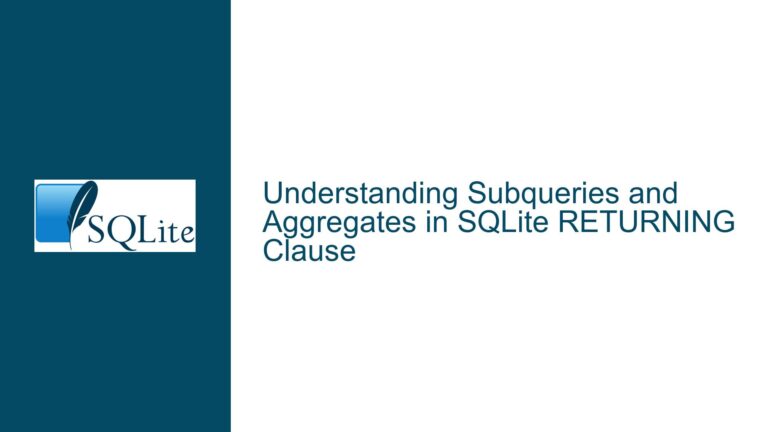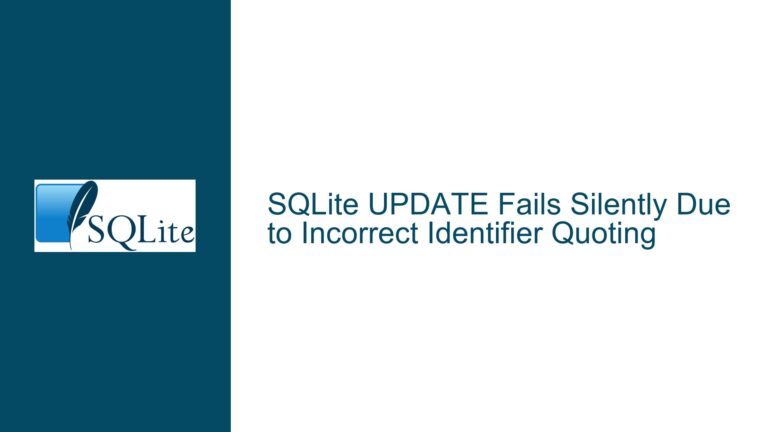SQLite Date Arithmetic: Handling Month and Year Overflow
Issue Overview: SQLite’s Date Arithmetic Behavior with Month and Year Overflow
SQLite’s date arithmetic functions, such as date(), are designed to handle date manipulations like adding or subtracting years or months from a given date. However, a nuanced issue arises when the resulting date falls into a scenario where the day of the month does not exist in the target month or year. For example, subtracting 110 years from 2024-02-29 results in 1914-03-01 instead of 1914-02-28. This behavior is due to SQLite’s default approach to handling date overflow, which rolls the date forward into the next month when the target date is invalid (e.g., February 29 in a non-leap year or January 31 when adding a month to a month with fewer than 31 days).
This behavior contrasts with other systems like PostgreSQL, which truncate the date to the last valid day of the target month. For instance, subtracting 110 years from 2024-02-29 in PostgreSQL yields 1914-02-28. The discrepancy arises from differing interpretations of how to handle invalid dates during date arithmetic. SQLite’s approach is deliberate and has been consistent for over two decades, prioritizing backward compatibility and a specific logic for date normalization.
The core issue revolves around the ambiguity of what constitutes a "valid" date when performing arithmetic operations that span months or years. This ambiguity is particularly pronounced in edge cases like leap years, months with varying lengths, and fractional month or year calculations. The lack of a universal standard for handling such cases further complicates the matter, as different systems and programming languages adopt varying strategies.
Possible Causes: Ambiguity in Date Arithmetic and Normalization Rules
The root cause of the issue lies in the inherent ambiguity of date arithmetic, especially when dealing with months and years. Unlike days, which have a fixed duration, months and years vary in length. A month can have 28, 29, 30, or 31 days, and a year can have 365 or 366 days. This variability introduces complexity when performing arithmetic operations that span these units.
SQLite’s default behavior is to normalize dates by rolling them forward into the next month when the target date is invalid. For example:
- Adding one month to
2024-01-31results in2024-03-02because February 31 does not exist, and SQLite rolls the date forward. - Subtracting 110 years from
2024-02-29results in1914-03-01because February 29, 1914, does not exist, and SQLite rolls the date forward.
This approach ensures that the resulting date is always valid, but it may not align with user expectations or the behavior of other systems. For instance, some users might expect the date to be truncated to the last valid day of the target month, as PostgreSQL does. This discrepancy highlights the lack of a universal standard for handling date overflow in date arithmetic.
Another contributing factor is the handling of fractional months and years. When dealing with fractional values, the ambiguity increases, as the system must decide how to distribute the fractional part across days, hours, minutes, and seconds. SQLite’s current approach favors rolling dates forward, which can lead to unexpected results when fractional values are involved.
Troubleshooting Steps, Solutions & Fixes: Addressing Date Arithmetic Ambiguity in SQLite
To address the ambiguity in date arithmetic, SQLite has introduced new modifiers to provide users with more control over how date overflow is handled. These modifiers, ceiling and floor, allow users to choose between rolling dates forward or truncating them to the last valid day of the target month. This enhancement ensures backward compatibility while offering flexibility for users who prefer a different approach.
Using the ceiling Modifier
The ceiling modifier maintains SQLite’s default behavior of rolling dates forward into the next month when the target date is invalid. For example:
SELECT date('2024-02-29', '-110 years', 'ceiling');
This query returns 1914-03-01, as the date is rolled forward to the next valid day.
Using the floor Modifier
The floor modifier truncates the date to the last valid day of the target month, aligning with the behavior of systems like PostgreSQL. For example:
SELECT date('2024-02-29', '-110 years', 'floor');
This query returns 1914-02-28, as the date is truncated to the last valid day of February 1914.
Practical Examples
Adding One Month to January 31:
- Default behavior (ceiling):
SELECT date('2024-01-31', '+1 month');Returns
2024-03-02. - Using the
floormodifier:SELECT date('2024-01-31', '+1 month', 'floor');Returns
2024-02-29(or2024-02-28in a non-leap year).
- Default behavior (ceiling):
Subtracting One Year from February 29:
- Default behavior (ceiling):
SELECT date('2024-02-29', '-1 year');Returns
2025-03-01. - Using the
floormodifier:SELECT date('2024-02-29', '-1 year', 'floor');Returns
2025-02-28.
- Default behavior (ceiling):
Fractional Month Calculations:
- Default behavior (ceiling):
SELECT date('2024-01-31', '+0.5 months');Returns
2024-02-15. - Using the
floormodifier:SELECT date('2024-01-31', '+0.5 months', 'floor');Returns
2024-02-14.
- Default behavior (ceiling):
Best Practices
- Documentation: Clearly document the behavior of date arithmetic functions, including the use of
ceilingandfloormodifiers, to ensure users understand how to achieve their desired results. - Testing: Thoroughly test date arithmetic operations, especially in edge cases like leap years and month boundaries, to verify that the results align with expectations.
- Consistency: Maintain consistency in date arithmetic logic across your application to avoid confusion and ensure predictable behavior.
By providing users with the flexibility to choose between ceiling and floor modifiers, SQLite addresses the ambiguity in date arithmetic while preserving backward compatibility. This enhancement empowers users to tailor date calculations to their specific needs, ensuring accurate and predictable results in all scenarios.






